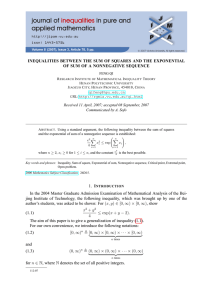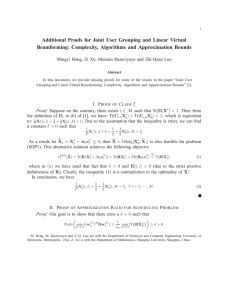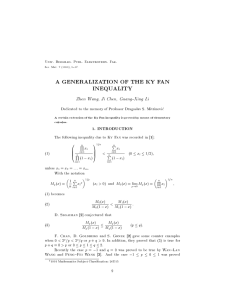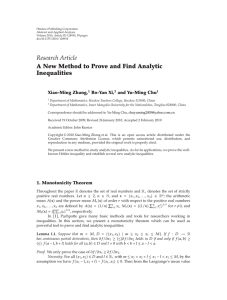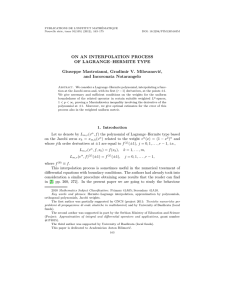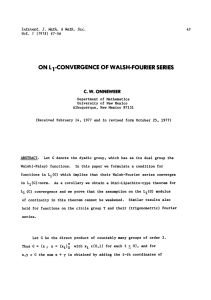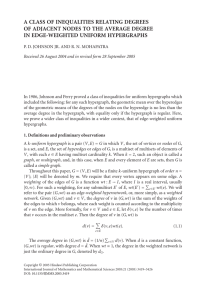A GENERALIZATION OF KY FAN’S INEQUALITY PENG GAO
advertisement
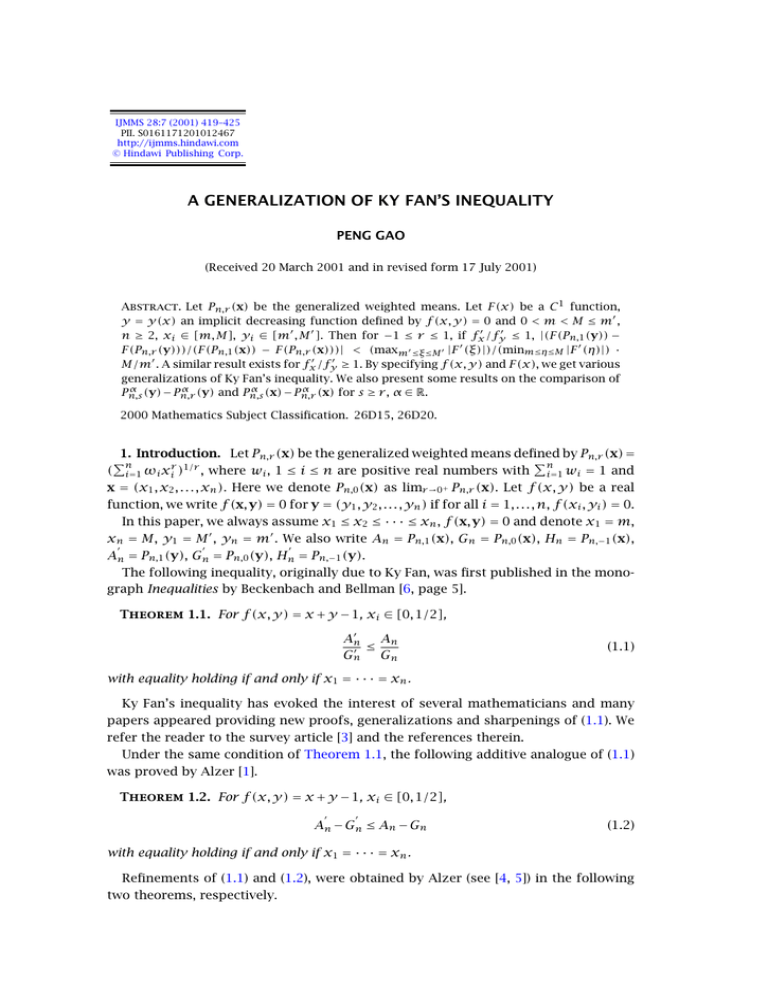
IJMMS 28:7 (2001) 419–425 PII. S0161171201012467 http://ijmms.hindawi.com © Hindawi Publishing Corp. A GENERALIZATION OF KY FAN’S INEQUALITY PENG GAO (Received 20 March 2001 and in revised form 17 July 2001) Abstract. Let Pn,r (x) be the generalized weighted means. Let F (x) be a C 1 function, y = y(x) an implicit decreasing function defined by f (x, y) = 0 and 0 < m < M ≤ m , n ≥ 2, xi ∈ [m, M], yi ∈ [m , M ]. Then for −1 ≤ r ≤ 1, if fx /fy ≤ 1, |(F (Pn,1 (y)) − F (Pn,r (y)))/(F (Pn,1 (x)) − F (Pn,r (x)))| < (max m ≤ξ≤M |F (ξ)|)/(minm≤η≤M |F (η)|) · M/m . A similar result exists for fx /fy ≥ 1. By specifying f (x, y) and F (x), we get various generalizations of Ky Fan’s inequality. We also present some results on the comparison of α (y) − P α (y) and P α (x) − P α (x) for s ≥ r , α ∈ R. Pn,s n,r n,s n,r 2000 Mathematics Subject Classification. 26D15, 26D20. 1. Introduction. Let Pn,r (x) be the generalized weighted means defined by Pn,r (x) = n n ( i=1 ωi xir )1/r , where wi , 1 ≤ i ≤ n are positive real numbers with i=1 wi = 1 and x = (x1 , x2 , . . . , xn ). Here we denote Pn,0 (x) as limr →0+ Pn,r (x). Let f (x, y) be a real function, we write f (x, y) = 0 for y = (y1 , y2 , . . . , yn ) if for all i = 1, . . . , n, f (xi , yi ) = 0. In this paper, we always assume x1 ≤ x2 ≤ · · · ≤ xn , f (x, y) = 0 and denote x1 = m, xn = M, y1 = M , yn = m . We also write An = Pn,1 (x), Gn = Pn,0 (x), Hn = Pn,−1 (x), An = Pn,1 (y), Gn = Pn,0 (y), Hn = Pn,−1 (y). The following inequality, originally due to Ky Fan, was first published in the monograph Inequalities by Beckenbach and Bellman [6, page 5]. Theorem 1.1. For f (x, y) = x + y − 1, xi ∈ [0, 1/2], An An ≤ Gn Gn (1.1) with equality holding if and only if x1 = · · · = xn . Ky Fan’s inequality has evoked the interest of several mathematicians and many papers appeared providing new proofs, generalizations and sharpenings of (1.1). We refer the reader to the survey article [3] and the references therein. Under the same condition of Theorem 1.1, the following additive analogue of (1.1) was proved by Alzer [1]. Theorem 1.2. For f (x, y) = x + y − 1, xi ∈ [0, 1/2], A n − Gn ≤ A n − Gn (1.2) with equality holding if and only if x1 = · · · = xn . Refinements of (1.1) and (1.2), were obtained by Alzer (see [4, 5]) in the following two theorems, respectively. 420 PENG GAO Theorem 1.3. Let xi ∈ (0, 1/2] (i = 1, 2, . . . , n; n ≥ 2) and m < M, then A − G n M m < n . < 1−m An − Gn 1−M (1.3) Theorem 1.4. Let xi ∈ [a, b] (i = 1, 2, . . . , n; 0 < a < b < 1), then An Gn (a/(1−a))2 < An < Gn An Gn (b/(1−b))2 . (1.4) Recently, Mercer obtained the following generalized Ky Fan’s inequality [7]. Theorem 1.5. For f (x, y) = x p + y p − 1, p ≥ 1, n ≥ 2, xi ∈ [0, 2−(1/p) ], Pn,1 (x)Pn,0 (y) ≥ Pn,1 (y)Pn,0 (x) (1.5) with equality holding if and only if x1 = · · · = xn . Our main goal in this paper is to present a theorem which provides essentially a unified treatment of Theorems 1.1, 1.2, 1.3, 1.4, and 1.5 and also gives new extensions of Ky Fan’s inequality. In Section 3, applications to Ky Fan’s inequality will be given by specifying the functions f (x, y), F (x). α α α (y) − Pn,r (y) and Pn,s (x) − More generally, we can talk about the comparison of Pn,s α α α α α Pn,r (x) for real α. The case of An − Gn and An − Gn was discussed in [5] and we will give some results related to the general case in Section 4. 2. The main theorem Theorem 2.1. Let F (x) be a C 1 function, y = y(x) an implicit decreasing function defined by f (x, y) = 0 and 0 < m < M ≤ m , n ≥ 2. Then for −1 ≤ r ≤ 1, if fx /fy ≤ 1, F Pn,1 (y) − F Pn,r (y) maxm ≤ξ≤M F (ξ) M < · . (2.1) F P (x) − F P (x) minm≤η≤M F (η) m n,1 n,r If fx /fy ≥ 1, F Pn,1 (y) − F Pn,r (y) minm ≤ξ≤M F (ξ) m · < max m≤η≤M F (η) M F Pn,1 (x) − Pn,r (x) (2.2) provided the denominators on both sides are nonzero. Proof. Since the proofs of (2.1) and (2.2) are very similar, we only prove (2.1) for r ≠ 0 here, the case r = 0 is also similar. We will consider the case F (x) = x first. We define for 1 ≤ i ≤ n − 1 and 0 < x < xi+1 : xi = x, . . . , x, xi+1 , . . . , xn , yi = y, . . . , y, yi+1 , . . . , yn , (2.3) D xi = xn Pn,1 xi − Pn,r xi − yn Pn,1 yi − Pn,r yi , 1−r 1−r g xi = xn Pn,r xi · x r −1 + yn Pn,r yi · y r −1 , and Di (x) = D(xi ), gi (x) = g(xi ). 421 A GENERALIZATION OF KY FAN’S INEQUALITY We need to show that D1 (x1 ) > 0. Differentiation of D1 (x1 ) yields 1−r 1−r f · x r −1 + yn x 1 − Pn,r yi · y r −1 Ωi−1 Di (x) = xn 1 − Pn,r xi fy 1−r 1−r ≤ xn 1 − Pn,r xi · x r −1 + yn 1 − Pn,r yi · y r −1 (2.4) = xn + yn − gi (x), where Ωi = Consider gi (x) i j=1 ωi . 1−2r 1−2r xn xjr fx yn yjr P P x y n,r i n,r i = −(1 − r ) ωj · r +1 − · · r +1 x x fy y y j=i+1 n 1−2r 1−2r xn xjr yn yjr P x y P n,r i n,r i ≤ −(1 − r ) ωj · r +1 − · r +1 < 0. x x y y j=i+1 N (2.5) The last inequality holds, since when −1 ≤ r ≤ 1/2, k = i + 1, . . . , n, we have 1−2r 1−2r Pn,r yi Pn,r xi ≥ , x y yk xk > , x y (2.6) r 1+r 1+r xj xj xn x · ≥ > , yn yj yj y when 1/2 ≤ r ≤ 1, we have Pn,r xi 1−2r xn 1−2r ≥ , x x xn yn 2−2r xj · yj r ≥ xj yj 2−2r Pn,r yi 1−2r yn 1−2r ≤ , y y xj · yj r = xj yj 2−r > x y (2.7) 2−r . Thus gi (x) > gi (xi+1 ) = gi+1 (xi+1 ) ≥ gi+1 (xi+2 ) ≥ · · · ≥ gn−1 (xn−1 ) ≥ gn−1 (xn ) = xn + yn , which implies Di (x) < 0 for all x ∈ (0, xi+1 ), so D1 x1 ≥ D1 x2 = D2 x2 ≥ D2 x3 ≥ · · · ≥ Dn−1 xn−1 ≥ Dn−1 xn = 0. (2.8) Since Di is strictly decreasing, we conclude from m < M that D1 (x1 ) > 0. Next, for arbitrary F , by using the mean value theorem, (2.1) is equivalent to F Pn,1 (y) − F Pn,r (y) F (ξ) Pn,1 (y) − Pn,r (y) = · , F Pn,1 (x) − F Pn,r (x) F (η) Pn,1 (x) − Pn,r (x) (2.9) where m ≤ ξ ≤ M , m ≤ η ≤ M. Taking absolute value and applying the result for F (x) = x, we get the desired inequality (2.1). This completes the proof. 422 PENG GAO 3. Consequences of Theorem 2.1. In this section, by choosing different functions f (x, y), F (x), we will give several results of generalized Ky Fan’s inequality of type (2.1). There are corresponding ones of type (2.2) and we leave the statements to the reader. To simplify expressions, we define ∆s,r ,α = with α α Pn,s (y) − Pn,r (y) α α Pn,s (x) − Pn,r (x) ln Pn,s (y)/Pn,r (y) . ∆s,r ,0 = ln Pn,s (x)/Pn,r (x) (3.1) (3.2) Also in order to include the case of equality for various inequalities in our discussion, we define 0/0 = 1 from now on. As a generalization of Theorem 1.3, we have the following corollary. Corollary 3.1. Let f (x, y) = ax p + by p − 1, 0 < a ≤ b, p ≥ 1, 0 < m < M ≤ (a + b)−(1/p) , n ≥ 2. For α ≤ 1, let F (x) = ln x if α = 0, or F (x) = x α , otherwise. Then for −1 ≤ r < 1 M 2−α . (3.3) ∆1,r ,α < m Proof. This follows from fx /fy ≤ 1, maxm ≤ξ≤M |F (ξ)|/ minm≤η≤M |F (η)| ≤ (M/m )1−α . We remark here in Corollary 3.1, the case α = 0 gives Pn,1 (y)/Pn,r (y) < (Pn,1 (x)/ 2 Pn,r (x))(M/m ) , which partially generalizes Theorem 1.4. Also for the case α = 0, by only assuming xi ∈ [0, (a+b)−(1/p) ], we get Pn,1 (y)/Pn,r (y) ≤ Pn,1 (x)/Pn,r (x) for −1 ≤ r ≤ 1 with the equality holding if and only if x1 = · · · = xn . This is a generalization of Theorem 1.5. As a generalization of Theorem 1.2, we have the following corollary. Corollary 3.2. Let f (x, y) = ax p +by p −1, 0 < a ≤ b, p ≥ 1, xi ∈ [0, (a+b)−1/p ]. For α ≤ 1, let F (x) = ln x if α = 0 or F (x) = x α , otherwise. Then for −1 ≤ r ≤ p 0 < ∆1,r ,α ≤ 1 (3.4) with equality holding if and only if x1 = · · · = xn . Proof. The first inequality is trivial, and the second inequality for the case −1 ≤ r ≤ 1 follows from (3.3) by noticing M/m ≤ 1. For 1 ≤ r ≤ p, we will prove the case α = 1 and the general case follows from using the mean value theorem. We define for 1 ≤ i ≤ n − 1 and xn−i < x ≤ M xi = x1 , . . . , xn−i , x, . . . , x , yi = y1 , . . . , yn−i , y, . . . , y , E xi ) = Pn,r xi − An xi − Pn,r yi + An yi , and Ei (x) = E(xi ). (3.5) 423 A GENERALIZATION OF KY FAN’S INEQUALITY We need to show that E1 (xn ) ≥ 0, notice first for x1 ≤ · · · ≤ xn (1−r )/2 Pn,r (x)Pn,r (y) Pn,r (x) ≥2 , (3.6) xn yn 1/r n xj yi r xi yj r Pn,r (x)Pn,r (y) 2 xi yi r = ωi + ωi ωj + . xn yn xn yn xn yn xn yn i=1 1≤i<j≤n 1−r r −1 · xn + Pn,r (y)1−r · ynr −1 (3.7) Since the function x[(1/b)(1 − ax p )]1/p is increasing for 0 ≤ x p ≤ 1/2a, we have (xi yi /xn yn )r ≤ 1 for all i. Now for fixed i ≤ j, define h(x) = 2xjr yjr − y r xjr − x r yjr , p−1 (3.8) r −p then h (xi ) ≤ r xi yi xjr − r xir −1 yjr ≤ 0 since r ≤ p and xi /yi ≤ 1 ≤ yj /xj . Thus h(xi ) = 2xjr yjr − yir xjr − xir yjr ≥ h(xj ) = 0, which implies xi yj xn yn r + xj yi xn yn r ≤ xi yj xj y j r + xj yi xj yj r = r xi xj + yi yj r ≤ 2. (3.9) Back to (3.7), we have Pn,r (x)Pn,r (y) = xn yn n xr ωi ir xn i=1 n yr ωi ir yn i=1 In particular this gives (where Ωi−1 = 1/r ≤ n ω2i + i=1 1/r 2ωi ωj = 1. i<j (3.10) n k=n−i+1 ωk ) 1−r 1−r a x p−1 · x r −1 − 1 + · p−1 Pn,r yi · y r −1 − 1 Ωi−1 Ei (x) = Pn,r xi b y 1−r 1−r ≥ Pn,r xi · x r −1 − 1 + Pn,r yi · y r −1 − 1 ≥ 0. Thus we deduce E1 xn ≥ E1 xn−1 = E2 xn−1 ≥ · · · ≥ En−1 x2 ≥ En−1 x1 = 0. (3.11) A close look of the proof tells us the equality holds in (3.4) if and only if x1 = · · · = xn and the proof is completed. As a special case of the above corollary, we have An −Hn ≤ An −Hn for generalized weighted means, a proof of this for the special case where ω1 = · · · = ωn was given in [2]. We remark here if 0 < b < a, then in general Pn,1 (x) − Pn,r (x) and Pn,1 (y) − Pn,r (y) are not comparable. For example, if we let a = 2, b = 1, n = 2, ω1 = ω2 , then when x1 = 1/3, x2 = 1/27, A2 − G2 = A2 − G2 ; when x1 = 1/3, x2 = 0, A2 − G2 > A2 − G2 and when x1 = 1/3, x2 = 1/4, A2 − G2 < A2 − G2 . The classical case of Ky Fan’s inequality corresponds to the choice of f (x, y) = x + y − 1, where fx /fy = 1. In this case both inequalities (2.1) and (2.2) hold and combinations of previous results yield the following corollary. 424 PENG GAO Corollary 3.3. For f (x, y) = x +y −1, 0 < m < M ≤ 1/2, n ≥ 2 then for −1 ≤ r ≤ 1, α ≤ 1 2−α 2−α m M < ∆1,r ,α < . (3.12) 1−m 1−M α α α α 4. The comparison of Pn,s (y) − Pn,r (y) and Pn,s (x) − Pn,r (x). In this section, fixing f (x, y) = x + y − 1, xi ∈ [0, 1/2], we give some results relating the comparison of α α α α Pn,s (y) − Pn,r (y) and Pn,s (x) − Pn,r (x), where s > r , α ∈ R. Our first result is the following lemma. Lemma 4.1. Given s > r , if for α0 ∈ R, we have ∆s,r ,α0 ≤ (≥)1 with equality holding if and only if x1 = · · · = xn , then for all α ≤ (≥)α0 , ∆s,r ,α ≤ (≥)1 with equality holding if and only if x1 = · · · = xn . α (v) − Proof. Let i = s, r , v = x, y, we can assume Pn,i (v) ≠ 0. If α0 ≠ 0, write Pn,s α0 α0 α0 α0 α/α0 α/α0 α−α0 = (Pn,s (v)) −(Pn,r (v)) = (α/α0 )ξ (Pn,s (v)−Pn,r (v)) with Pn,r (v) < α α ξ < Pn,s (v), where when α = 0, we define (Pn,i0 (v))0/α0 = ln Pn,i0 (v). By taking the quoα tient, we get the desired result. If α0 = 0, we write Pn,i (v) = eα ln Pn,i (v) and proceed similarly. α (v) Pn,r For any s ≥ r , the above lemma enables us to define a number sup(α)s,r such that ∆s,r ,α ≤ 1 holds for all α < sup(α)s,r . A special case of this, sup(α)1,0 = 1 was determined in [5]. The inequality ∆s,r ,α ≥ 1 seems unusual but indeed it can happen, even for the case r = 1. Indeed we have the following theorem. Theorem 4.2. ∆s,1,α ≥ 1 for α ≥ s ≥ 2; ∆s,1,α ≤ 1 for 1 < s ≤ 2, α ≤ s; ∆1,r ,α ≤ 1 for α ≤ r < 0, in all cases the equality holds if and only if x1 = · · · = xn . Proof. From Lemma 4.1, it suffices to prove the theorem for α = s or r . In this case, for x ∈ [0, 1/2], consider the function f (x) = x t − (1 − x)t with f (x) = t(t − 1)(x t−2 − (1 − x)t−2 ). By considering the sign f (x) for various t and using corre sponding Jensen’s inequality: ωi f (xi ) ≥ (≤)f ( ωi xi ), the above assertions follow. In Theorem 4.2, by restricting xi ∈ [m, M], 0 < m < M ≤ 1/2, we will get results similar to Corollary 3.3 and we will leave the statements to the reader. We have omitted the case 0 < r < 1 for Theorem 4.2 since we have a stronger result as Corollary 3.2. We point out an interesting phenomena here that when s = 2, ∆2,1,α ≥ (≤)1 for α ≥ (≤)2. We also remark here the proof of (1.1) follows by applying Jensen’s inequality to the function ln x − ln(1 − x) for x ∈ [0, 1/2]. Notice Pn,s (x)−Pn,r (x) ≥ Pn,s (y)−Pn,r (y) does not hold for arbitrary real numbers s ≥ r , for otherwise we will have Pn,s (x)/Pn,r (x) ≥ Pn,s (y)/Pn,r (y) which is not true in general according to a nice result by Chen and Wang [8]. Theorem 4.3. For arbitrary n, s > r , xi ∈ (0, 1/2], ∆s,r ,0 ≤ 1 holds if and only if |r + s| ≤ 3, 2r /r ≥ 2s /s when r > 0, r 2r ≤ s2s when s < 0. By using Lemma 4.1 and Theorem 4.3, we get the following theorem. A GENERALIZATION OF KY FAN’S INEQUALITY 425 Theorem 4.4. sup(α)s,r ≥ 0 if |r + s| ≤ 3, 2r /r ≥ 2s /s when r > 0, r 2r ≤ s2s when s < 0. Moreover, sup(α)1,r = 1 for −1 ≤ r ≤ 1 and sup(α)s,1 = s for 1 < s ≤ 2. Proof. The first assertion follows from Theorem 4.3 and the definition for sup(α)s,r . From Corollary 3.2, we know that sup(α)1,r ≥ 1 for −1 ≤ r ≤ 1 and when α > 1, let x1 = 1/2, x2 = · · · = xn = , and α α α α f ω1 , = Pn,1 (x) − Pn,r (x) − Pn,1 (y) − Pn,r (y) . (4.1) A simple calculation reveals that there exist positive real numbers δ and η such that we have f (ω1 , ) < 0, if 0 < ω1 < δ and 0 < < η and f (ω1 , ) > 0, if 1 − δ < ω1 < 1 and 0 < < η. Similar conclusion holds for sup(α)s,1 and this completes the proof. References [1] [2] [3] [4] [5] [6] [7] [8] H. Alzer, Ungleichungen für geometrische und arithmetische Mittelwerte [Inequalities for geometric and arithmetic means], Nederl. Akad. Wetensch. Indag. Math. 50 (1988), no. 4, 365–374 (German). MR 90a:26034. Zbl 0655.26010. , An inequality for arithmetic and harmonic means, Aequationes Math. 46 (1993), no. 3, 257–263. MR 94h:26021. Zbl 0785.26012. , The inequality of Ky Fan and related results, Acta Appl. Math. 38 (1995), no. 3, 305–354. MR 96a:26017. Zbl 0834.26013. , On an additive analogue of Ky Fan’s inequality, Indag. Math. (N.S.) 8 (1997), no. 1, 1–6. MR 99c:26013. Zbl 0873.26009. , Some inequalities for arithmetic and geometric means, Proc. Roy. Soc. Edinburgh Sect. A 129 (1999), no. 2, 221–228. MR 2000c:26012. Zbl 0923.26013. E. F. Beckenbach and R. Bellman, Inequalities, Ergebnisse der Mathematik und ihrer Grenzgebiete, vol. 30, Springer-Verlag, Berlin, 1961. MR 28#1266. Zbl 0097.26502. A. McD. Mercer, Bounds for A–G, A–H, G–H, and a family of inequalities of Ky Fan’s type, using a general method, J. Math. Anal. Appl. 243 (2000), no. 1, 163–173. MR 2001a:26021. Zbl 0944.26027. Z. Wang and J. Chen, Generalization of Ky Fan inequality, Math. Balkanica (N.S.) 5 (1991), no. 4, 373–380 (1992). MR 93g:26030. Zbl 0755.26010. Peng Gao: Department of Mathematics, University of Michigan, 2074 East Hall, 525 East University Avenue, Ann Arbor, MI 48109, USA E-mail address: penggao@umich.edu
